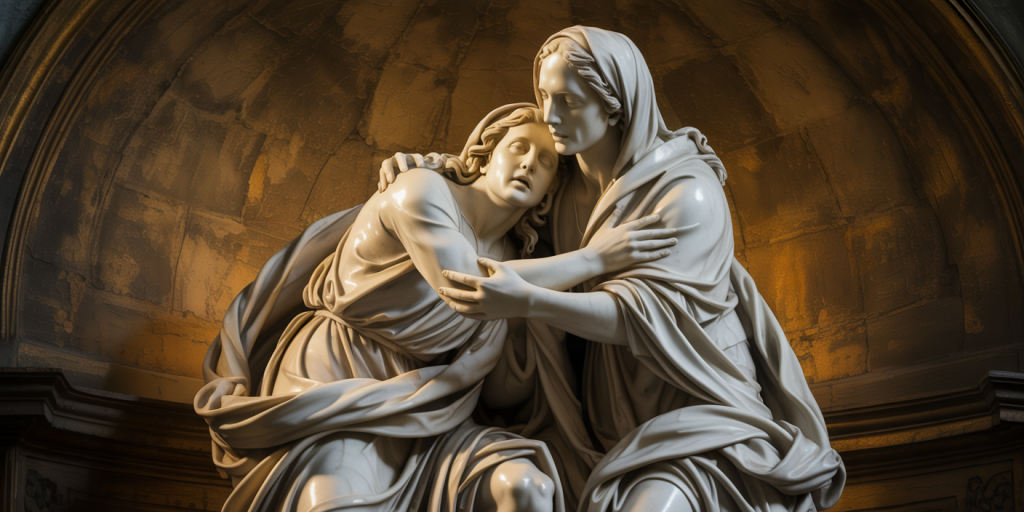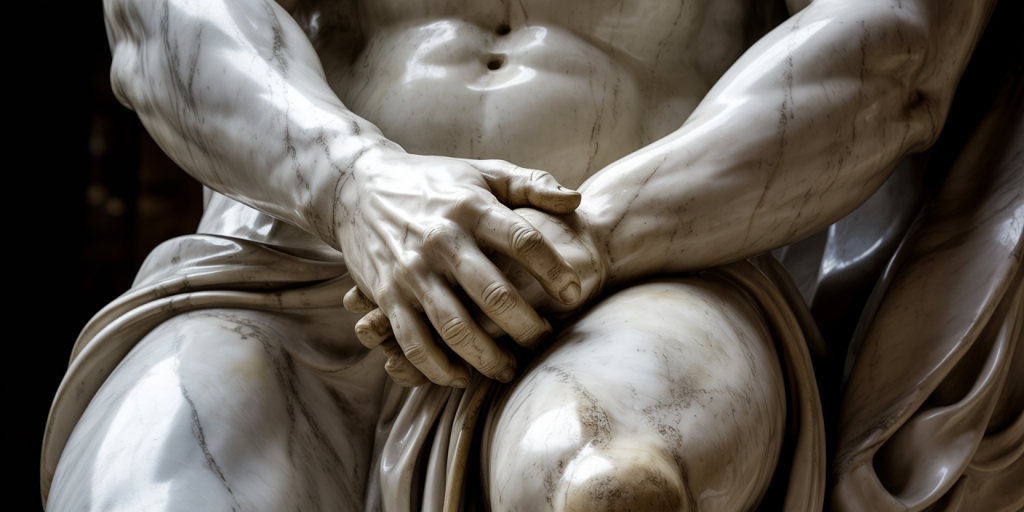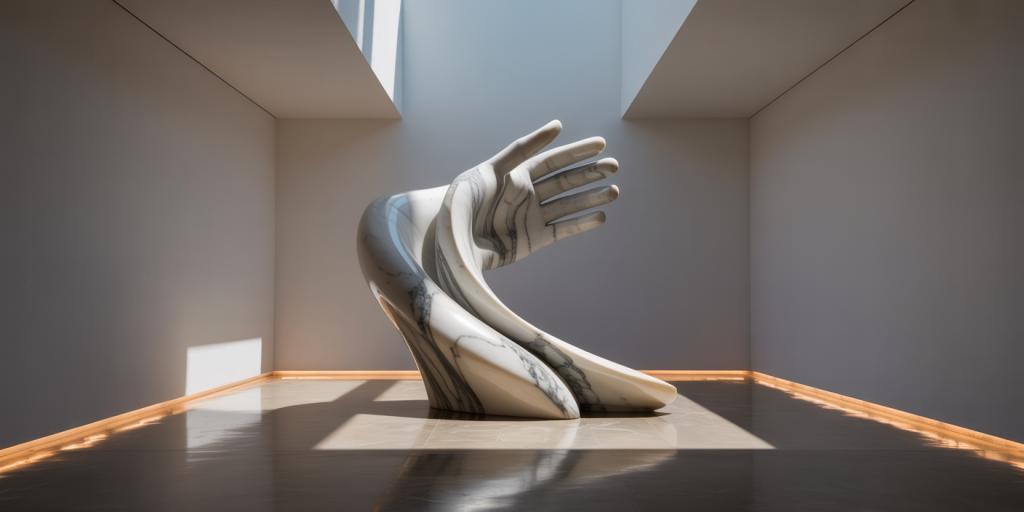The Hands of Bernini Touch the Invisible
There are moments in art when matter breathes — when marble exhales, and silence grows weighty as a sigh between lovers. Bernini did not merely sculpt; he summoned the immaterial. In his hands, stone trembles with sensation, flesh pulses through veined white, and the divine whispers through touch. These are not hands that carve but hands that listen — to pain, to ecstasy, to time itself.
Standing before his works is to stand at the threshold between worlds — where human drama becomes myth, and myth becomes the memory of the invisible. In every curve lies a confession. In every fingertip, a trace of something sacred. Bernini’s hands did not shape gods. They revealed the tremor in their breath.
Table of Contents
- The Whisper Beneath the Veins of Marble
- Draperies That Shiver Like Skin
- A Touch Suspended in Time
- From Silence, a Shout: The Emotion in Stone
- The Sacred and the Sensual
- The Breath Between Two Fingers
- Light Crawling Across Flesh
- The Eyes That Never Close
- Texture as Revelation
- The Divine in the Ordinary
- The Psychological Pulse of Pose
- When the Human Becomes Monument
- Weightless Weight: Gravity Defied
- The Body as Prayer
- Stillness in Motion
- Bernini’s Theater of the Soul
- Sculpting the Moment Before
- Echoes of Myth and Mortality
- The Sculpture That Sees You
The Whisper Beneath the Veins of Marble
Bernini’s marble does not lie still. It murmurs with breath, quivers with the remembrance of movement. His chisel follows not form but feeling — tracing veins as if they were secrets whispered under the skin. In his sculptures, marble becomes not medium, but memory.
The viewer is drawn not only to the representation of bodies but to what those bodies conceal: the fear in a calf muscle, the tremble of surrender in a wrist. Bernini speaks the language of gesture — one learned not in academies, but in silence.

Draperies That Shiver Like Skin
The folds of fabric Bernini sculpts are not just garments — they are emotional topographies. The drapery clings, rebels, floats, and collapses. It resists gravity, behaving like a dream held in tension.
These textures mirror inner lives. A flurry of cloth across a torso might echo fear. A soft ripple over the thigh might speak of vulnerability. Bernini does not sculpt bodies draped in fabric — he sculpts souls wrapped in movement.
A Touch Suspended in Time
His most famous touches — Daphne’s fleeing limbs, Pluto’s grasp, or the caress of Saint Teresa — are not frozen. They live in an eternal second before the climax. A moment stretched like breath before the storm.
It is this almost that gives his work its power. Viewers do not witness action. They witness anticipation. Tension hums in fingertips. Energy circles like wind between figures.
From Silence, a Shout: The Emotion in Stone
Emotion in Bernini’s work does not scream. It rises, it surges, it stings. Faces twist in ecstasy or despair not as caricatures but as truths — raw and without apology.
He understood that emotion is not only in eyes or mouths, but in the curve of a shoulder, the angle of a hip. The soul speaks through bones. And Bernini listened.
The Sacred and the Sensual
Bernini’s sacred figures pulse with sensuality. The divine, in his hands, is not distant. It sweats, pants, weeps. Saint Teresa’s orgasmic rapture is not heresy — it is holiness embodied.
This fusion of flesh and spirit is what makes his religious works unsettling and magnetic. Heaven is not up in Bernini’s world. It is under the skin.
The Breath Between Two Fingers
Consider the hand of Pluto pressing into Proserpina’s thigh — marble dimpling under the grip. That moment — that impossibility — is Bernini’s triumph. He sculpts pressure. He sculpts breath.
It is not the touch we see, but what the touch implies: resistance, violation, surrender. The fingers become voices. The skin, an echo chamber.

Light Crawling Across Flesh
Bernini’s play of light is not accidental. He sculpts for shadow — for the movement of day over cheekbones, the passage of hours over stone. His figures transform depending on the angle of sun.
In darkness, they brood. In daylight, they breathe. This light choreography gives the illusion of time passing through the work — making the eternal feel temporal, alive.
The Eyes That Never Close
Even when blindfolded, Bernini’s figures see. Their sockets are carved not for sight, but for awareness. One feels watched — not by gods, but by the idea of being seen.
The intensity of expression in their eyes — wide, pleading, or half-lidded — conveys emotional narratives that words cannot hold. These are eyes that judge, love, ache.
Texture as Revelation
Bernini’s textures defy expectation. Skin appears soft. Hair coils in rebellious strands. Beards carry the weight of age. Wings stretch as if mid-beat.
Each surface — polished or coarse — tells us something about the subject’s inner world. Texture becomes psychology. Smoothness signals surrender. Roughness, resistance.
The Divine in the Ordinary
Even in his lesser-known busts and tombs, Bernini finds the extraordinary in the mundane. A wrinkle across a brow becomes a hymn. A sagging cheek tells a life’s story.
This reverence for detail — for the human condition — transforms marble from decorative to confessional. We do not see saints. We see ourselves elevated to myth.
The Psychological Pulse of Pose
Bernini’s figures never stand still. Their poses twist, reach, flee, lean. Each posture is an emotion embodied. A raised arm is a question. A bent knee, a decision.
These gestures do not decorate. They narrate. And in narrating, they confess — silently, but with the intensity of shouted truth.
When the Human Becomes Monument
In monuments like The Ecstasy of Saint Teresa, Bernini dissolves the line between sculpture, architecture, and theater. The human becomes landscape. Emotion becomes architecture.
We are not outside the scene. We are inside it. Lit by the same divine spotlight. Touched by the same trembling revelation.
Weightless Weight: Gravity Defied
How does one make marble float? Bernini knew. His veils, his robes, his angels — they ascend. His works do not defy gravity. They ignore it.
There is levity in his tension. His sculptures carry the paradox of weightless weight. Solidity dances. Matter prays.
The Body as Prayer
Each of Bernini’s bodies is a supplication. Bent knees, outstretched arms, arching backs — they do not merely move. They plead.
Even in erotic moments, there is devotion. Desire, in Bernini’s hands, becomes spiritual hunger. His bodies do not only want. They worship.
Stillness in Motion
Bernini mastered stillness — but only as a paradox. His works do not move. Yet they breathe with potential. They vibrate with the next.
This tension between inertia and anticipation is what makes them unforgettable. They haunt. They linger. They live on the edge of becoming.
Bernini’s Theater of the Soul
His sculptural settings — niches, altars, hidden windows — create a stage. Light is the spotlight. Viewers are the audience. The soul is the actor.
Bernini knew how to direct. He composed each figure like a scene. And in doing so, he transformed churches into performances of faith.

Sculpting the Moment Before
What defines Bernini is not the action, but its anticipation. He sculpts the breath before the leap, the tear before it falls.
This ‘almost’ is his genius. It invites the viewer to complete the moment — to imagine the future and remember the past. His sculpture becomes a collaboration with time.
Echoes of Myth and Mortality
Bernini’s use of myth — Apollo and Daphne, Pluto and Proserpina — is not escapism. It is commentary. Through these stories, he speaks of consent, fate, desire, resistance.
Marble becomes mirror. Myth becomes metaphor. And through it, we confront ourselves — our urges, our silences, our longing to be seen.
The Sculpture That Sees You
Finally, Bernini’s work is never passive. It watches. It judges. It forgives. It waits. In its silence, it speaks truths too loud for words.
You do not merely observe Bernini. You are observed. Not by a god — but by the divine you carry within.
FAQ
Who was Gian Lorenzo Bernini?
Bernini (1598–1680) was an Italian Baroque sculptor, architect, and painter, celebrated for transforming marble into vivid emotional experiences.
What defines Bernini’s sculptural style?
His mastery of light, texture, movement, and psychological intensity. He captured fleeting moments in stone, often mixing the sacred and the sensual.
Why is Bernini considered revolutionary?
He redefined sculpture as theater. His works involve the viewer, creating immersive experiences that transcend visual admiration.
What is his most famous work?
The Ecstasy of Saint Teresa, Apollo and Daphne, and Pluto and Proserpina are among his most iconic pieces.
What emotions are evoked in his works?
Ecstasy, fear, surrender, desire, divinity — each sculpture is a constellation of feelings rendered in flesh-like marble.
Final Reflections: When Stone Learns to Feel
Bernini did not ask marble to mimic life. He asked it to remember it. In every chisel mark, he inscribed breath, ache, and divinity. His hands did not merely carve forms — they communed with the invisible.
To gaze upon his work is to feel seen. To touch the edge of the eternal. And to understand that even silence has weight — when shaped by hands that knew how to make stone weep, sing, and pray.
